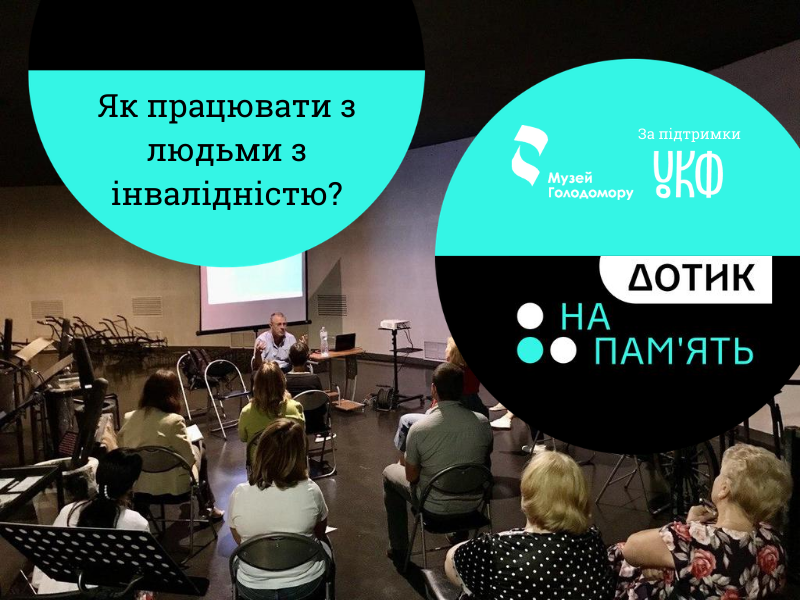How to Work with People with Disabilities?
Olha and Yevhen Sviet, specialists in accessibility and inclusion, conducted a public online lecture on the psychology of visually impaired people and a seminar-consultation on guiding visually impaired people. This is how the museum team continues to work on the project “Touch the Memory”.
One of the global tasks of the Holodomor Museum in 2020 is to ensure its accessibility. With the support of the Ukrainian Cultural Foundation, we are implementing two projects: “Touch the Memory”, during which we are adapting educational classes and excursions for blind people, and “Accessible site — accessible museum”, during which our museum site is being adapted to international standards.
As part of the “Touch the Memory” project, a public online lecture “Psychology of Visually Impaired People” was held. Teacher for the visually impaired and accessibility specialist Olha Sviet explained what typhlopsychology is, what it studies why it is important to understand its basics, and about the psychology of visually impaired people, feelings and types of perception.
Yevhen Sviet held a practical seminar-consultation, where he told about the rules of guiding blind people indoors (including in the museum), on the street, in public transport and more. Museum staff tried on the roles of the guides and the guided, and practically trained to conduct tours for visually impaired visitors.
We asked Yevhen Sviet what accessibility is, what are the stereotypes and problems related to the topic of accessibility in Ukraine.
- ABOUT ACCESSIBILITY
“Accessibility is a simple thing that concerns every person, every institution. We do not single out any target group (people with disabilities) and places where such people can appear most often. Anyone at one time or another in life may find themselves in the category of people who are called low mobility groups (MGN), ie need accessibility.
MGN is a category of people who at a particular time have difficulty in moving (moving) space, navigating in space, receiving information or services, communication with the environment and so on. The category of IGN includes people with disabilities, pregnant women, parents with young children, children under six, the elderly, people with temporary health problems, people with heavy suitcases, women in heels, people who for some reason are not oriented on the ground, people in a state of stress, alcohol intoxication, etc. That is, it can be argued that up to 90% of the population of Ukraine can belong to the category of IGN.
The basis of accessibility is the physical ability of each user of goods, services or institutions to enter the premises, as well as physical security and comfort while receiving the relevant services. There should be convenient access to information, the ability to navigate normally in space, goods, services. Accessibility applies to any business process, institution that offers goods or services, government agencies, medical, social, educational institutions, transportation facilities, and so on. It is impossible to sell the goods if there is no opportunity to get to the premises, buy products and have information about the range. If we do not provide accessibility to every institution, then we do not provide the opportunity for our services to be purchased. “
- ABOUT THE STEREOTYPES:
“There are many stereotypes. Today we discussed two kinds of them. The first group includes stereotypes of relatively healthy people about people with disabilities. The stereotype is that people with disabilities are a small group that needs artificial conditions, that needs to be pitied or admired. ‘They’ are not like ‘us’, ‘they’ are special and need something special.
The second group of stereotypes is the stereotypes of some people with disabilities about relatively healthy people. The main idea is that someone owes someone something (“everyone else owes me something, because I have a certain peculiarity”). This is a very dangerous stereotype, because while cooperating and interacting, the relations must be built on equal terms, and only then will it be true inclusion. Inclusion is not the responsibility of healthy people, inclusion is our shared responsibility. People with disabilities also have to work for inclusion. ”
- ABOUT AVAILABILITY IN UKRAINE
“Accessibility in Ukraine needs to be developed systematically. If you allocate funds for something narrowly focused, there will be no result. In my opinion, when individual grants are allocated and inclusion is created, it remains artificial, does not work and is not inclusion at all, but at best just narrow accessibility. In the worst case, inclusion is completely forgotten after the project had ended. It is very good that the public sectors are dealing with this issue now, but there should be public policy, not grants, but permanent funding. Although a lot of money is being allocated to certain projects now, in addition to money, awareness and motivation are needed. Going back to the beginning, everyone is really interested in inclusion. “
Summaries of all lectures given to our museum team appear in the “Accessibility” section of our museum website, some of them are published in video format on our Youtube channel.
